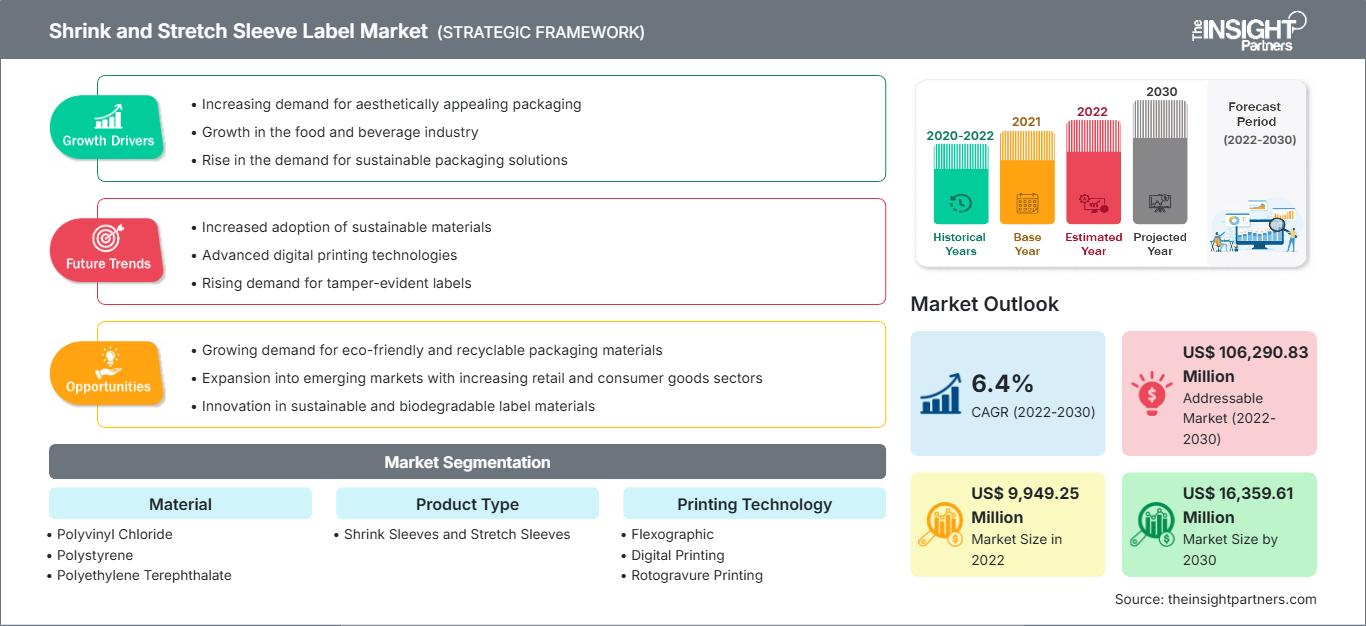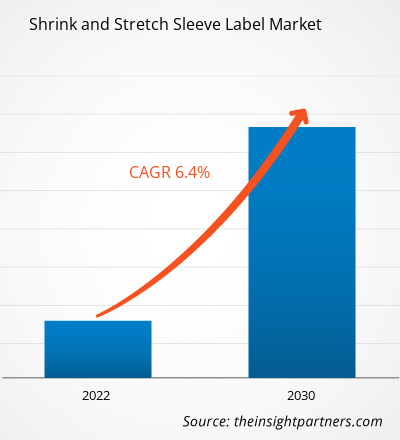[研究报告] 2022 年收缩和拉伸套标市场规模为 99.4925 亿美元,预计到 2030 年将达到 163.5961 亿美元;预计 2022 年至 2030 年的复合年增长率为 6.4%。
市场分析
收缩和拉伸套标市场体现出一种动态格局,这种格局受不断变化的消费者偏好、技术进步以及对可持续包装解决方案的关注所驱动。随着包装行业的持续增长,对视觉吸引力和信息丰富的标签的需求导致收缩和拉伸套标的采用日益增多。这些标签通过生动的图形和 360 度品牌推广,为产品差异化提供了一种多功能解决方案。在制造商寻求可持续替代品的背景下,合规性和对环保包装的重视使套标更具吸引力。市场受益于印刷技术的创新,这些创新使得复杂的设计和智能包装功能的融入成为可能。
技术进步在塑造市场格局中发挥着至关重要的作用,印刷技术的不断创新使得复杂的设计和智能包装功能的整合成为可能。包装公司、标签制造商和最终用户的行业合作营造了创新和高效的环境。拉伸和收缩套标用途广泛,可应用于食品饮料、药品和个人护理等多个领域,促进了市场的持续增长。
增长动力与挑战
收缩和拉伸套标提供 360 度覆盖,呈现生动且视觉上吸引人的图形。这些标签使品牌能够通过创意包装设计和标签形状来区分其产品。这些标签具有防篡改功能,可确保包装产品的完整性。食品和饮料饮料行业竞争激烈,货架吸引力在食品和饮料需求中扮演着重要角色。便携式和单份包装在该行业越来越受欢迎。此外,收缩套标的设计使其在使用过程中受热时能够紧密贴合产品容器的轮廓。这种贴合特性使标签能够适应各种形状和尺寸的瓶子、罐子、容器和其他物品。紧密贴合使包装呈现出美观无缝的外观。收缩套标还能起到有效的防篡改密封作用,为包装产品提供额外的安全保障。然而,拉伸和收缩套标由聚氯乙烯、聚乙烯和聚对苯二甲酸乙二醇酯等塑料制成。这些材料在可回收性方面存在挑战,并且它们在废物流中的存在可能会引起环境问题。拉伸和收缩套标的广泛使用会产生塑料废物,对环境构成风险。
自定义此报告以满足您的要求
您将免费获得任何报告的定制,包括本报告的部分内容,或国家级分析、Excel 数据包,以及为初创企业和大学提供超值优惠和折扣
收缩和拉伸套标市场: 战略洞察

- 获取本报告的主要市场趋势。这个免费样本将包括数据分析,从市场趋势到估计和预测。
您将免费获得任何报告的定制,包括本报告的部分内容,或国家级分析、Excel 数据包,以及为初创企业和大学提供超值优惠和折扣
收缩和拉伸套标市场: 战略洞察

- 获取本报告的主要市场趋势。这个免费样本将包括数据分析,从市场趋势到估计和预测。
报告细分与范围
《全球收缩和拉伸套标市场分析与预测(2030年)》是一项专业且深入的研究,重点关注全球市场趋势和增长机遇。本报告旨在概述全球市场,并根据材料、产品类型、印刷技术、最终用途行业和地域进行详细的市场细分。报告提供了全球收缩和拉伸套标使用情况的关键统计数据,以及主要地区和国家的需求。此外,报告还对影响主要地区和国家收缩和拉伸套标市场表现的各种因素进行了定性评估。报告还对收缩和拉伸套标市场的主要参与者及其关键战略发展进行了全面分析。本文还包括市场动态分析,以帮助识别关键驱动因素、市场趋势和有利可图的机会,进而有助于识别主要收入来源。
生态系统分析和波特五力分析提供了全球收缩和拉伸套筒标签市场的 360 度视角,有助于了解整个供应链和影响市场增长的各种因素。
细分分析
全球收缩和拉伸套筒标签市场根据材料、产品类型、印刷技术和最终用途行业进行细分。根据材料,市场细分为聚氯乙烯、聚苯乙烯、聚对苯二甲酸乙二醇酯、聚乙烯等。聚氯乙烯是一种用途广泛的热塑性聚合物,以其透明度、柔韧性和成本效益而闻名。它通常因其在收缩过程中加热时能够有效地贴合包装形状的能力而受到青睐。它具有可观的收缩率。就拉伸套筒标签而言,聚氯乙烯因其柔韧性和耐用性而被广泛使用。根据产品类型,市场分为收缩套筒和拉伸套筒。收缩套筒由柔性塑料材料制成,遇热后会收缩紧贴包装轮廓。收缩套筒由聚氯乙烯、聚对苯二甲酸乙二醇酯或其他塑料薄膜等材料制成。根据印刷技术,市场细分为柔版印刷、数码印刷、轮转凹版印刷等。柔版印刷技术以其高质量的印刷和经济高效而闻名。因此,该技术是收缩和拉伸套筒标签制造的首选。它是一种可重复的工艺,适用于大批量标签生产,并适用于套筒生产中常用的各种薄膜类型和厚度。根据最终用途行业,市场细分为食品和饮料、药品、化学品、消费品、个人护理和化妆品、汽车和运输等。拉伸和收缩套标在食品和饮料行业中发挥着至关重要的作用,既具有功能性,又能满足市场营销需求。拉伸和收缩套标广泛用于果汁、能量饮料和酒精饮料等食品和饮料产品。这些标签的保护性密封可防止食品和饮料产品被有意或无意地打开。
区域分析
本报告详细概述了全球收缩和拉伸套标市场,涵盖五大主要区域——北美、欧洲、亚太地区 (APAC)、中东和非洲 (MEA) 以及南美洲和中美洲 (SAM)。亚太地区占据全球收缩和拉伸套标市场的最大份额,2022 年市场价值超过 40 亿美元。亚太地区是食品和饮料制造商的聚集地,也是该地区中型企业的中心。预计到2030年,欧洲的市场规模将超过45亿美元。预计北美在2022年至2030年间的复合年增长率约为5%。消费者追求便利的生活方式在拉伸和收缩套标市场的增长中起着关键作用。随着人们生活节奏的加快,对包装食品的需求也随之激增。
行业发展与未来机遇
以下列出了收缩和拉伸套标市场主要参与者采取的各种举措:
2023年4月,Berry宣布扩建其位于田纳西州刘易斯堡的领先薄膜制造工厂。
收缩和拉伸套标市场
The Insight Partners 的分析师已详尽阐述了预测期内影响收缩和拉伸套标市场的区域趋势和因素。本节还探讨了北美、欧洲、亚太地区、中东和非洲以及南美和中美洲的收缩和拉伸套标市场细分和地域分布。
收缩和拉伸套标市场报告范围
| 报告属性 | 细节 |
|---|---|
| 市场规模 2022 | US$ 9,949.25 Million |
| 市场规模 2030 | US$ 16,359.61 Million |
| 全球复合年增长率 (2022 - 2030) | 6.4% |
| 历史数据 | 2020-2022 |
| 预测期 | 2022-2030 |
| 涵盖的领域 |
By 材料
|
| 覆盖地区和国家 | 北美
|
| 市场领导者和主要公司简介 |
|
收缩和拉伸套标市场参与者密度:了解其对业务动态的影响
收缩和拉伸套标市场正在快速增长,这得益于终端用户需求的不断增长,而这些需求的驱动因素包括消费者偏好的不断变化、技术进步以及对产品优势的认知度不断提高。随着需求的增长,企业正在扩展产品线,不断创新以满足消费者需求,并抓住新兴趋势,从而进一步推动市场增长。

- 获取 收缩和拉伸套标市场 主要参与者概述
新冠疫情的影响/地缘政治形势的影响/经济衰退的影响
新冠疫情爆发前,全球许多国家都报告了经济增长。主要制造商投资于收缩和拉伸套标的研发。他们还专注于通过并购扩大地域覆盖范围,以满足广泛的客户群。疫情爆发前,由于化学品和材料行业的需求不断增长,收缩和拉伸套标市场报告了稳步增长。疫情期间,供应链中断、原材料和劳动力短缺以及运营困难造成了供需缺口,对化学品和材料行业的增长产生了不利影响。制造商报告称,从供应商采购原材料和配料面临挑战,影响了收缩和拉伸套标的生产率。
由于化学品和材料行业的需求波动,一些地区报告了供需缺口。 2021年,疫苗接种率的上升推动了各国整体状况的改善,为化工和材料行业创造了有利的环境。随着化工和材料行业企业恢复生产和销售运营,收缩和拉伸套标的销量有所增长。这些行业对高质量收缩和拉伸套标解决方案的需求不断增长,推动了收缩和拉伸套标市场的增长。
竞争格局和主要公司
CCL Industries Inc.、Huhtamaki Oyj、Berry Global Group Inc.、Amcor Plc、Coveris Management GmbH、Stratus Packaging SAS、KP Holding GmbH & Co KG、Fuji Seal International Inc、Oerlemans Plastics BV 和 Maca Srl 是收缩和拉伸套标市场的主要参与者。
- 历史分析(2 年)、基准年、预测(7 年)及复合年增长率
- PEST和SWOT分析
- 市场规模、价值/数量 - 全球、区域、国家
- 行业和竞争格局
- Excel 数据集
近期报告
相关报告
客户评价
购买理由
- 明智的决策
- 了解市场动态
- 竞争分析
- 客户洞察
- 市场预测
- 风险规避
- 战略规划
- 投资论证
- 识别新兴市场
- 优化营销策略
- 提升运营效率
- 顺应监管趋势




















 获取免费样品 - 收缩和拉伸套标市场
获取免费样品 - 收缩和拉伸套标市场